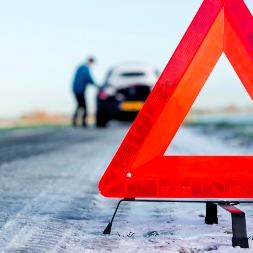Avoid Vehicle Hazards
Vehicle inspections and safety features help protect drivers and passengers from deadly driving hazards, but may not be enough. Preparing for situations, such as those listed here, in advance can help reduce the risk of a serious accident, injuries and death.
Runaway Engine
While driving, your vehicle suddenly starts to accelerate and you can’t stop.
- In a vehicle with an automatic transmission, shift the engine into neutral to slow it down.
- In a vehicle with a manual transmission, step on the clutch pedal. The engine will still race but the vehicle will not accelerate.
- Help prevent this from occurring by removing all floor mats from the driver’s side.
- Do not turn off the engine while the vehicle is moving because braking and steering will require more effort.
Inspect Your Vehicle
Before going on any long-distance trip, prepare your car for the haul.
- Check the oil, coolant and brake fluid levels.
- Fill up the windshield washer fluid.
- Check your tires’ air pressure and wear.
- Ensure all lights and signals are functioning properly.
Brake Failure
While rare because of safety features, it can still happen.
- Pump your brakes hard and fast if you have an older vehicle.
- Shift your vehicle into a lower gear so the engine slows.
- Keep your foot on the brake. The failure may be temporary and if the brakes suddenly start working again, your foot will be where it needs to be.
Skidding and Hydroplaning
Wet roads can make driving very difficult, especially if you are driving fast.
- Reduce your speed but don’t slam on the brakes.
- Maintain control of the steering wheel.
- Help prevent this from occurring by having the proper air pressure and tread on your tires.
Tire Blowout
Road debris, a defective rim, tire pressure that is too low or too high, or a worn tire can cause a blowout.
- Don’t slam on your brakes or immediately release your foot from the gas.
- Maintain control of the steering wheel.
- When the car is in control, gradually lift your foot from the gas and slow down.






